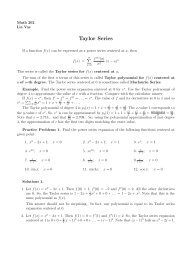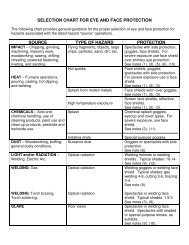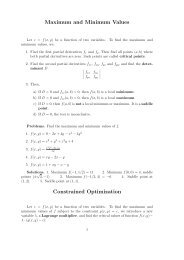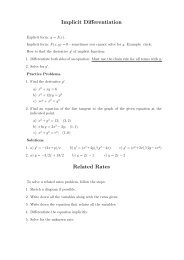Second and Higher Order Linear Differential Equations
Second and Higher Order Linear Differential Equations
Second and Higher Order Linear Differential Equations
Create successful ePaper yourself
Turn your PDF publications into a flip-book with our unique Google optimized e-Paper software.
Math 320<br />
Lia Vas<br />
<strong>Second</strong> <strong>and</strong> <strong>Higher</strong> <strong>Order</strong> <strong>Linear</strong> <strong>Differential</strong> <strong>Equations</strong><br />
A second order differential equation is linear if it can be written in the form<br />
a(x)y ′′ + b(x)y ′ + c(x)y = g(x).<br />
The general solution of such equation will depend on two constants. An initial-value problem<br />
for the second order equation consists of finding the solution of the second order differential<br />
equation that satisfies the conditions<br />
y(x0) = y0 <strong>and</strong> y ′ (x0) = y1.<br />
An boundary-value problem for the second order equation consists of finding the solution<br />
of the second order differential equation that satisfies the conditions<br />
y(x0) = y0 <strong>and</strong> y(x1) = y1.<br />
A linear differential equation is called homogeneous if g(x) = 0. To find the general<br />
solution of such differential equation, it is sufficient to find two solution y1(x) <strong>and</strong> y2(x) which<br />
are not constant multiple of one another (linearly independent solutions). Then, the general<br />
solution has the form<br />
y(x) = c1y1(x) + c2y2(x).<br />
If a homogeneous equation has constant coefficients (that is if a, b <strong>and</strong> c are constants,)<br />
then the function of the form y = e rx is a solution iff r is a solution of characteristic equation<br />
ar 2 + br + c = 0<br />
To see this, calculate the derivatives: y = e rx , y ′ = re rx , <strong>and</strong> y ′′ = r 2 e rx <strong>and</strong> substitute that<br />
into the equation ay ′′ + by ′ + cy = 0. We have that ar 2 e rx + bre rx + ce rx = (ar 2 + br + c)e rx = 0<br />
if <strong>and</strong> only if r is a solution of ar 2 + br + c = 0.<br />
Because of this, the general solution of the differential equation ay ′′ + by ′ + cy = 0 can be<br />
obtained by solving the characteristic equation ar 2 + br + c = 0. Depending on the sign of the<br />
discriminant b 2 − 4ac, there are three cases.<br />
Case 1 If the characteristic equation has two real <strong>and</strong> distinct roots r1 <strong>and</strong> r2, then the two linearly<br />
independent solutions are e r1x <strong>and</strong> e r2x <strong>and</strong> the general solution is y = c1e r1x + c2e r2x .<br />
Case 2 If the characteristic equation has one real root r, then the two linearly independent<br />
solutions are e rx <strong>and</strong> xe rx <strong>and</strong> the general solution is y = c1e rx + c2xe rx .<br />
Case 3 If the characteristic equation has two complex roots p ± iq, then the two linearly independent<br />
solutions are e px cos qx <strong>and</strong> e px sin qx <strong>and</strong> the general solution is y = c1e px cos qx +<br />
c2e px sin qx.<br />
1
Practice Problems.<br />
a) Solve the following differential equations.<br />
1. y ′′ − 6y ′ + 8y = 0<br />
2. y ′′ − y − 6y = 0<br />
3. y ′′ − 2y ′ + y = 0<br />
4. y ′′ − 4y ′ + 4y = 0<br />
5. y ′′ − 2y ′ + 2y = 0<br />
6. y ′′ + 4y = 0<br />
b) Solve the following initial-value problems.<br />
1. y ′′ − 6y ′ + 8y = 0, y(0) = 0, y ′ (0) = 2<br />
2. y ′′ − y − 6y = 0, y(0) = 0, y ′ (0) = 5<br />
3. y ′′ − 2y ′ + y = 0, y(0) = 2, y ′ (0) = 3<br />
4. y ′′ − 4y ′ + 4y = 0, y(0) = 2, y ′ (0) = 7<br />
5. y ′′ + 4y = 0, y(0) = 2, y ′ (0) = 2<br />
c) Solve the following boundary-value problems.<br />
1. y ′′ − 6y ′ + 8y = 0 y(0) = 0, y(1) = e 2<br />
2. y ′′ − 2y ′ + y = 0, y(0) = 2, y(1) = e<br />
3. y ′′ − 2y ′ + 2y = 0, y(0) = 1, y(π/2) = 2e π/2<br />
4. y ′′ + 4y = 0, y(0) = 3, y(π/4) = −2<br />
Solutions.<br />
a) 1. y = c1e 2x + c2e 4x<br />
2. y = c1e 3x + c2e −2x<br />
3. y = c1e x + c2xe x<br />
4. y = c1e 2x + c2xe 2x<br />
5. y = c1e x cos x + c2e x sin x<br />
6. y = c1 cos(2x) + c2 sin(2x)<br />
b) 1. y = −e 2x + e 4x<br />
2. y = e 3x − e −2x<br />
3. y = 2e x + xe x<br />
4. y = 2e 2x + 3xe 2x<br />
5. y = 2 cos(2x) + sin(2x)<br />
2
c) 1. y = 1<br />
1−e 2 e 2x − 1<br />
1−e 2 e 4x<br />
2. y = 2e x − 2xe x<br />
3. y = e x cos x + 2e x sin x<br />
4. y = 3 cos(2x) − 2 sin(2x)<br />
<strong>Higher</strong> <strong>Order</strong> <strong>Linear</strong> <strong>Differential</strong> <strong>Equations</strong><br />
The method of solving homogeneous differential equations of second order generalizes for<br />
solving homogeneous differential equations of higher order with constant coefficients.<br />
Recall that a linear higher order differential equation is of the form an(x)y (n) +an−1(x)y (n−1) +<br />
. . . + a0(x)y = g(x). A homogeneous linear differential equation with constant coefficients has<br />
the form<br />
any (n) + an−1y (n−1) + . . . + a0y = 0.<br />
Its general solution can be determined by finding n linearly independent solutions of its characteristic<br />
equation<br />
anr n + an−1r n−1 + . . . + a0 = 0.<br />
If r1, r2, . . . , rn are different real solutions, then e r1x , e r2x , . . . , e rnx are linearly independent<br />
solutions producing a general solution<br />
y = c1e r1x + c2e r2x + . . . + cne rnx .<br />
Similarly as in the case of repeated roots, if r1 = r2 = ri for some i ≤ n, then e r1x , xe r1x , . . . ,<br />
x i e rix are linearly independent solutions that generate a general solution.<br />
Examples. Solve the equations: a) y ′′′ − 2y ′′ − y ′ + 2y = 0, b) y ′′′ − 2y ′′ + y ′ = 0.<br />
Solution. a) The characteristic equation is r 3 − 2r 2 − r + 2. Factoring this equation by<br />
h<strong>and</strong> (get (r − 1)(r + 1)(r − 2) = 0) or solving it using Matlab or the calculator, we obtain the<br />
solutions r = 1, −1, 2. Thus, the three linearly independent solutions are e x , e −x <strong>and</strong> e 2x <strong>and</strong><br />
the general solution is y = c1e x + c2e −x + c3e 2x .<br />
b) The characteristic equation is r 3 −2r 2 +r = 0. Factoring this equation, we get r(r−1) 2 = 0,<br />
so r = 0 is a solution <strong>and</strong> r = 1 is a double root. Thus, the three linearly independent solutions<br />
are e 0x = 1, e x <strong>and</strong> xe x <strong>and</strong> the general solution is y = c1 + c2e x + c3xe x .<br />
In order to better underst<strong>and</strong> the complex roots case, below is a short review of complex<br />
numbers.<br />
Complex Numbers<br />
Complex numbers are introduced during the course of the study of algebraic equations <strong>and</strong>,<br />
in particular, the solutions of equations that involve square roots of negative real numbers.<br />
As usual, we denote the √ −1 with i. A complex number is any expression of the form<br />
a + ib where a <strong>and</strong> b are real numbers. a is called the real part <strong>and</strong> b is called the imaginary<br />
3
part of the complex number a+ib. The complex number a−ib is said to be complex conjugate<br />
of the number a + ib.<br />
Trigonometric Representations. Let us recall the polar coordinates x = r cos θ <strong>and</strong><br />
y = r sin θ. Using this representation, we have that<br />
z = x + iy = r cos θ + ir sin θ.<br />
The value r is the distance from the point (x, y) in the plane to the origin. The value r is<br />
called the modulus or absolute value of z. The angle θ is the angle between the radius vector<br />
of (x, y) <strong>and</strong> the positive part of x-axis. The angle θ is usually called the argument or phase<br />
of z.<br />
Euler’s formula.<br />
e iθ = cos θ + i sin θ.<br />
This formula is especially useful in the solution of differential equations. Euler’s formula was<br />
proved (in an obscured form) for the first time by Roger Cotes in 1714, then rediscovered <strong>and</strong><br />
popularized by Euler in 1748.<br />
For complex numbers, this allows the following simplification<br />
z = x + iy = r(cos θ + i sin θ) = re iθ<br />
With this formula, a lot of formulas involving complex numbers become simpler.<br />
For example, the trigonometric representation yields an easy formula for the n-th power of<br />
a complex number z = re iθ = r(cos(θ) + i sin(θ)),<br />
z n = r n e inθ = r n (cos(nθ) + i sin(nθ)).<br />
More importantly when solving algebraic equations of the form z n = a where a is a given<br />
complex number a = r(cos(θ) + i sin(θ)), we can obtain n solutions of the equation by the<br />
formula<br />
for k = 0, 1, . . . n − 1.<br />
(θ+2kπ)i<br />
n√<br />
re n = n√ θ + 2kπ<br />
r(cos + i sin<br />
n<br />
θ + 2kπ<br />
)<br />
n<br />
Fundamental Theorem of Algebra. A quadratic equation ax 2 +bx+c = 0 can have two<br />
(possibly equal) real solutions or no real solutions. As opposed to this situation, in complex<br />
plane, every quadratic equation has exactly two solutions (possibly equal). Similar claim holds<br />
for every polynomial: Every polynomial (with complex coefficients) of degree n has exactly n<br />
solutions (some possibly equal). This is statement is known as the Fundamental Theorem of<br />
Algebra (more details at http://en.wikipedia.org).<br />
Moreover, if an n-th degree polynomial with real coefficient has a complex root a + ib,<br />
then its complex conjugate a − ib is also the root of a polynomial. Thus, a polynomial with<br />
real coefficients of n-th degree has n roots even number of which is complex. The complex roots<br />
appear in conjugated pairs.<br />
Thus, if r1, r2, . . . , rn are roots of characteristic equation of a homogeneous linear differential<br />
equation with constant coefficients any (n) + an−1y (n−1) + . . . + a0y = 0, <strong>and</strong> if r1 = a + ib<br />
4
<strong>and</strong> r2 = a − ib are a conjugated complex pair, then two linearly independent solutions that<br />
correspond to this conjugated pair originate from<br />
e (a+ib)x = e ax e ibx = e ax (cos bx + i sin bx).<br />
Since the solutions are real-valued functions, two solutions can be taken to be e ax cos bx <strong>and</strong><br />
e ax sin bx.<br />
Finding zeros of polynomials in Matlab. Unlike the situation for quadratic equation,<br />
there is no general formula for polynomials of degrees higher than 4 (find out more at<br />
http://en.wikipedia.org/wiki/Polynomial#Solving polynomial equations). Even for cubic or<br />
quartic polynomials when such formula exists, it is rather complex to use. Thus, unless a polynomial<br />
is easy to factor or to use the n-th root formula, it is convenient to find approximate<br />
solutions using Matlab or some other technology.<br />
In Matlab, you can find zeros of polynomial anx n + an−1x n−1 + . . . + a1x + a0 = 0 by the<br />
comm<strong>and</strong> roots. Start by representing the polynomial as a vector of length n + 1 with its<br />
coefficients as the entries<br />
<strong>and</strong> then use the comm<strong>and</strong><br />
p=[an an−1 . . . a1 a0]<br />
roots(p)<br />
Example. Find general solution of the equation −90y (4) + 100y ′′′<br />
− 54y ′ + 16y = 0 by using<br />
Matlab to find solutions of characteristic equation.<br />
Solution. The characteristic equation is −90r4 + 100r3 − 54r + 16 = 0. Represent this<br />
polynomial in Matlab as p=[-90 100 0 -54 16] <strong>and</strong> use the comm<strong>and</strong> roots(p) to get the<br />
solutions r = -0.6900, 0.3511 <strong>and</strong> 0.7250±0.4562i. This gives you the four fundamental solutions<br />
y1 = e−0.69x , y2 = e0.3511x y3 = e0.7250x cos 0.4562x <strong>and</strong> y4 = e0.7250x sin 0.4562x. So, the general<br />
solution is y = c1e−0.69x + c2e0.3511x + c3e0.7250x cos 0.4562x + c4e0.7250x sin 0.4562x.<br />
Practice Problems:<br />
1. Find all the solutions of the equation x 4 = 1. Do the same for x 8 = 1.<br />
2. Find all the solutions of the equation x 3 = 8.<br />
3. Find all the solutions of the equation x 5 = 32.<br />
4. Solve the differential equation y (4) = y using the solutions of the ordinary equation x 4 = 1<br />
from above.<br />
5. Solve the differential equation y ′′′ = 8y using the solutions of the ordinary equation x 3 = 8<br />
from above.<br />
6. Solve the differential equation y (4) − 5y ′′ − 36y = 0.<br />
7. Find general solution of the equation −18y (5) + 25y (4) − 27y ′′<br />
+ 16y ′ + 20y = 0 by using<br />
Matlab to find solutions of characteristic equation.<br />
5
Solutions.<br />
1. Solutions of x 4 = 1 : ±1, ±i. Solutions of x 8 = 1 : ±1, ±i, ±1/ √ 2±i1/ √ 2, ±1/ √ 2∓i1/ √ 2.<br />
2. 2, −1 ± i √ 3.<br />
3. 2, 2(cos 2π/5 ± i sin 2π/5), 2(cos 4π/5 ± i sin 4π/5).<br />
4. Solutions of x 4 = 1 are ±1, ±i. Thus, the general solution of the differential equation is<br />
y = c1e t + c2e −t + c3 cos t + c4 sin t.<br />
5. Solutions of x 3 = 8 are 2, −1±i √ 3. Thus, the general solution of the differential equation<br />
is y = c1e 2t + c2e −t cos √ 3t + c3e −t sin √ 3t.<br />
6. The characteristic equation r 4 − 5r 2 − 36 factors as (r 2 − 9)(r 2 + 4). So, the solutions are<br />
3, −3, 2i, −2i. Thus the general solution is y = c1e 3x + c2e −3x + c3 cos 2x + c4 sin 3x.<br />
7. The characteristic equations corresponds to a polynomial p that can be represented in<br />
Matlab as p=[-18 25 0 -27 16 20]. The comm<strong>and</strong> roots(p) gives you the following<br />
values: 1.2971, 0.7664 ± 0.9707i <strong>and</strong> −0.7205 ± 0.2023i. Thus, the general solutions<br />
is y = c1e 1.2971x + c2e 0.7664x cos 0.9707x + c3e 0.7664x sin 0.9707x + c4e −0.7205x cos 0.2023x +<br />
c5e −0.7205x sin 0.2023x.<br />
6

















